When I first met Graham Phillips in the 90’s he cheerfully suggested that people interested in breeding in division 7 and 8 should be sent to the madhouse.
I have been waiting for a decisive result before writing this update. 12/16TX (99/2WT x Nordic Rim) pictured in the March journal, which unexpectedly produced a single seed last year, has been holding onto three beautiful hard fat pods.
It seemed obvious that I would be able to announce that the problem of fertile intersectional hybrids between tazettas and main division flowers was solved. Those pods have finally matured and they have yielded absolutely nothing at all. It makes one wonder if daffodils have a sense of humour. Which proves, I guess, that Graham has a point.

99/2WT is a great parent. It accepts a variety of pollen and conversely its pollen is accepted by a variety of seed parents. It has produced interesting apodanthi hybrids (13/26TX), triandrus hybrids (13/25TX) and hybrids with viridiflorus ancestry (13/6TX, 13/7TX). These are all highly sterile.
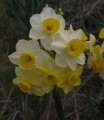


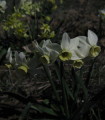
99/2WT has produced a near miniature when crossed with what I thought was an apodanthi but which appears to be a jonquilla (hence its number is now TJ rather than TA). Inexplicably this appears to have some fertility.

99/2WT is an exacting parent because it self pollinates readily to produce plants like itself (13/14WT) – it must be deanthered before the florets open.
99/2WT doesn’t appear to be very fond of paperwhite pollen but crossed with tazettas it produces big beautiful tazettas larger than either parent (07/2,5,6WT). In this photo 03/1WT is a marvel from Bill Welch’s Autumn Colors seed. Perhaps it is Autumn Colors x tetraploid paperwhite. Unfortunately it is quite sterile.



99/2WT is apparently Not-Paperwhite-Grandiflorus x Bairns Sol. The incorrectly identified seed parent was a Pearl type tazetta (WWT= 11+11+10) so it seems likely this hybrid has arisen from the rare event of non-reduction and has produced a fully fertile allotetraploid WWTT. This suggests that when it is crossed with tazettas it is producing Grand Monarque type hybrids (WTT). I suspect these hybrids are all seed fertile under favorable conditions. 07/2WT is proving to be a very reliable seed parent.
With this genetic makeup it seemed possible that 99/2WT crossed with main division flowers might produce fertile hybrids WWTT x NNNN -> NNWT so, with brimming optimism a variety of crosses were made. These started flowering in 2008 and all proved to be highly pollen sterile, hence the use of TX selection numbers which are intended to denote sterile hybrids. The project of producing fertile hybrids was abandoned until positive results started to appear recently. More of these hybrids have now set seed and one this year proved to be quite pollen fertile. It seems that, in spite of 12/16TX messing with me, it is quite likely that this line of breeding will produce a race of fertile hybrids. A cautionary example, however, is Winter Bells. It is plausibly the child of the highly sterile Silver Chimes. It itself has slight fertility but a seedling from triandrus and a main division flower have both proven highly sterile. Marginal fertility does not necessarily lead anywhere.
The main division x 99/2WT (and reverse) hybrids tend to be big, slow growing plants that flower later than either parent. In my frosty conditions they can have disproportionately short stems. They have good substance which means that dissimilar parents can produce flowers that are very determinedly out of shape. One suspects that as a race, this type of hybrid will be useful mainly as parents of sterile garden and show varieties of lower ploidy. It seems likely that there is no ideal solution to the problem of fertile intersectional tazetta hybrids. 12/15TX = 99/2WT x Nordic Rim. 12/17MT = (New Penny x Badbury Rings) x 99/2WT op. 13/35TX = Lemon Sails x 99/2WT.
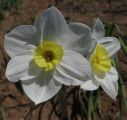
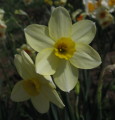

Matador has not been a great parent for me. I dislike the way the cup burns here in the sun. It selfs to give plants like itself. Theoretically it can be crossed with the sterile poetaz 17’s (NT) to give fertile hybrids. I may have a Geranium x Matador (the pollen that 12/16TX found so amusing), a Xerxes x Matador and a Matador x Geranium but these are not great plants. Perhaps the sterile poetaz 24’s (NNT) can produce an occasional NT gamete but I don’t plan to try it. I must have assumed that Green Goddess was a poetaz 24 because I put its pollen onto a tazetta. The few seedlings that resulted appear true to cross but are quite sterile (13/13TX). I no longer have Green Goddess but perhaps Matador x Green Goddess is worth a try. The poetaz 31 (NNNT?) Highfield Beauty is, not surprisingly, highly sterile.
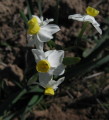
Many years ago Bill Welch sent me open pollinated seed from his 95/1. 95/1 I understand is Matador x [(Autumn Sol x Ballymarlow) op]. (12/18MT, 12/20MT) He also sent pollen which I think was from the same line. To this group has been added artificially tetraploided Cloth of Gold. This plant is hardly a show flower but it has yielded highly fertile vigorous plants – the strong yellows in the group photo. Matador x Cragford? is at the top of the photo. (Matador x Cragford?) x Cloth of Gold is front left. Behind it is 10/3MT = Cloth of Gold x Bill’s seedling.
Last of all is the well named dubius. A couple of its seedlings have flowered including a quite nice but non-miniature 8?Y-P. This plant, like 12/16TX, also looks as if it has a sense of humour. We’ll see.

So in conclusion, division 7 is certainly no longer a madhouse project, but division 8? Here that is still an open question. Of course, the intra-sectional hybrids are delightful and present no difficulties whatsoever (apart from frost). In the paperwhites, some strange things may be happening with broussonetii and dubius. Most interesting perhaps are some Mornington x pachybolbus which look like paperwhites but which have the green foliage indicative of hybrids. Mornington is a Pearl type plant (WWT) and so this hints that there is genetic exchange between the paperwhites and the colored tazettas.
This is the last of my fertility updates for the year. My conclusion across all these divisions is that now is an exciting time to be breeding daffodils. The fertility barriers are coming down and so very many things are possible.

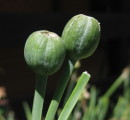



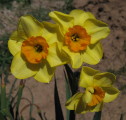
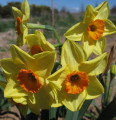

Lawrence:
Once again thank you for your very valuable insight!. If I might add, many of my intersectional hybrids using N. dubius do have limited fertility. I have only flowered the first few of many but those were nothing exceptional. Waiting in the wings are others that I hope will have more promise.
Harold
Lawrence this may not be your last post on the topic. As I told you I don’t know what a ploid is but I do find your writing interesting. Thanks.
Today I collected some seed from a Snipe x cyclamineus seedling. This collecting was from open pollinated seed pods, possibly selfed. How does this fit in with your conclusions relating to Div 6?
Dave
Hi Dave,
I think I’m the perfect person to answer your question – I use genetics all the time but am not too expert, and the genetics assumptions I use are simple. If you also breed animals then it is worth knowing that plant genetics is much less rigid.
The basic idea of genetics is that our characteristics are passed on from parent to child in strands called chromosomes (‘chromo’ because particular dyes attach to them and they become visible under the microscope). Our body construction is determined not by just one strand (in a highly specialised embryonic environment) but by a collection of strands. The number of strands is constant for a species, and each strand is distinct and can be given a name (a number). Each parent has 2 sets of strands/chromosomes and contributes just one set to their child so that the child also has 2 sets of strands, one set from each parent. People have 2 x 23 = 46 chromosomes- 1 1′, 2 2′, 3 3′ etc. In this process the chromosomes pair up and exchange pieces. Your child does not get one or other of each of your particular chromosomes. They get just one of each but it is a mixture of each of your 2 i.e. they inherit characteristics from both YOUR parents.
A species name is meant to collect all individuals that can form fertile offspring under one name. But there are barriers that stop plant populations interbreeding: – physical barriers, flowering time, pollinators etc. And so in plant taxonomy we can have different species names for types that WE can interbreed to form fertile offspring. In daffodils we try to gather these similar species that can successfully interbreed under names we call sections.
It is easy to see that there can be instances where assigning plant populations to species names cannot be perfect. Similarly, section categories may not be perfect either.
Unlike animals, plants can thrive even though they have more (or less) than two sets of chromosomes. Most species daffodils have 2 sets (diploid) but daffodils can also have 3 sets (triploid), 4 sets (tetraploid) etc. Intermediate numbers are also possible. The process of parents contributing half their chromosomes sets to their children means that plants with 4 sets of chromosomes can fairly reliably pass on half their sets of chromosomes (i.e. 2 sets) to their children. But this process becomes very muddled when a parent has 3 sets of chromosomes. We therefore expect tetraploids to be reasonably fertile and triploids to be quite sterile.
It has been discovered that the process of traditional daffodil breeding (div. 1,2,3) has favoured daffodils with 4 sets of chromosomes (tetraploids) such that, unless the pedigree suggests otherwise, all highly bred modern plants in these divisions can be assumed to be fertile tetraploids.
Putting all this together means that in daffodil breeding there are two important questions:
What is the ploidy (how many sets of chromosomes does the plant have)?
What is the section?
If we use a capital letter to stand for a SET of chromosomes and use different letters for the different sections then we have a genetic shorthand that is generally very effective in comprehending pedigrees and effective in predicting the outcome of crosses.
I represent the sections as follows: T for tazettas, W for paperwhites, R for triandrus, B for bulbocodium, J for jonquilla, A for apodanthi, U for juncifolia and N for the narcissus/pseudonarcissus group.
As it happens, most daffodil species have 7 chromosomes per set but tazettas have 10 , paperwhites 11, and serotinus 5. Bulbocodiums are diverse but I just carelessly suppose they have 7 chromosomes per set – obesus with 26 chromosomes seems to have established itself in pedigrees without too much trouble. Chromosome numbers, therefore, are not necessarily multiples of 7 because of the trouble triploids (and sometimes tetrploids) cause but also because of the different numbers that different sections may contribute.
In traditional breeding the ploidy is 4 and the the section is narcissus/pseudonarcissus and there is not much to worry about. NNNN (contributes NN) x NNNN (contributes NN) -> NNNN. Problems arise in division 6 because the section is the same but the ploidy is different. NNNN (contributes NN) x NN (contributes N) -> NNN. Division 9 is probably mostly NN x NN -> NN but crosses with division 3 may cause trouble (Killearnan?). It seems likely that division 9 will see the establishment of tetraploids.
Hybrids between sections are typically sterile – that is what ‘section’ implies. For example, cyclamineus x jonquilla would be NN x JJ -> NJ. Such a plant cannot pass on one set of chromosomes as a parent (even though it has 2 x 7 chromosomes) because the process of pairing up and dividing into two lots of one set cannot occur. If, however, we could create an NNJJ hybrid, the chromosomes could pair up, the N set with the N set and the J with the J, and the parent could then pass on half – ie. a set of NJ chromosomes.
Because of the color and quality of division 1-3 plants it is intersectional hybrids with these that are of most interest. In tazetta breeding the ideal is NNTT (contributes NT) x NNTT (contributes NT) -> NNTT. (These should have 2 x 7 + 2 x 10 = 34 chromosomes). The problem is how to obtain NNTT’s apart from Matador. Ideally we would do this from a tetraploid tazetta crossed with main division flowers i.e. NNNN x TTTT -> NNTT. You can see why I would hope that my 99/2WT, which seems to be WWTT, might do this and why the observation above that there is genetic exchange between W and T is significant. The breeding is NNNN (contributes NN) x WWTT (contributes WT) -> NNWT and the hope is that somehow on some occasions W and T can act as equal sets of chromosomes.
In division 7 breeding with main division flowers, plants such as Hillstar are NNJJ. Hillstar x Limequilla is NNJJ (contributes NJ) x NNJJ (contributes NJ) -> NNJJ. This is why viridiflorus (effectively JJJJ) and tetraploid jonquilla are important because we cross these with main division flowers to get fertile Hillstar types: NNNN (contributes NN) x JJJJ (contributes JJ) -> NNJJ.
In div. 5 Mission Bells appears to be NNRR. The possibility that sterile intersectional triploids such as Silver Bells (NNR) can pass on a set of N chromosomes plus a set of R chromosomes to its children is of vital importance, not just in this division but between sections generally, because it suggests a pathway to fertile hybrids that may have enough possibility of success to be worth pursuing.
So finally, in answer to your question, Snipe is undoubtedly NN (diploid with 14 chromosomes). From your comment below I gather the cyclamineus seedling is Snipe x cyclamineus and is therefore also NN. So your seedling is NN x NN -> NN. It is therefore likely to be fertile in the same way that Snipe and the cyclamineus hybrid is. If you want to introduce some characteristics of the highly bred main division flowers you can cross it with the sterile triploids and hope for the best, the more seed the better, or you can cross it with main division flowers directly and then take your chances with sterile triploids of your own. The seedling (40/95A) in Flight Path’s ancestry is interesting because of the possibility, unknown to me, that it could contribute NN to Flight Path and that Flight Path could be a normally fertile tetraploid similar to the tetraploid cyclamineus hybrids that Larry Force lists. If 40/95A is a diploid then Flight Path is a sterile triploid and for that reason a chancy parent.
Hopefully all this is logical and orderly and you can make sense of it. Good luck!
Lawrence,
It will take me some time to digest this too.
The seedling I got seeds from is first generation Snipe x N cyclamineus. In your writing on Div 6 you talked about a lot of sterility in the cultivars. Snipe, as a hybrid, is obviously fertile. I am suggesting that the next generation from Snipe may also be fertile in some way and useful for breeding further, maybe on to the larger main division flowers as you suggest.
Dave
Lawrence: A Tour de Force, and simply wonderful explanation. Thank you for putting in the effort!
Melissa